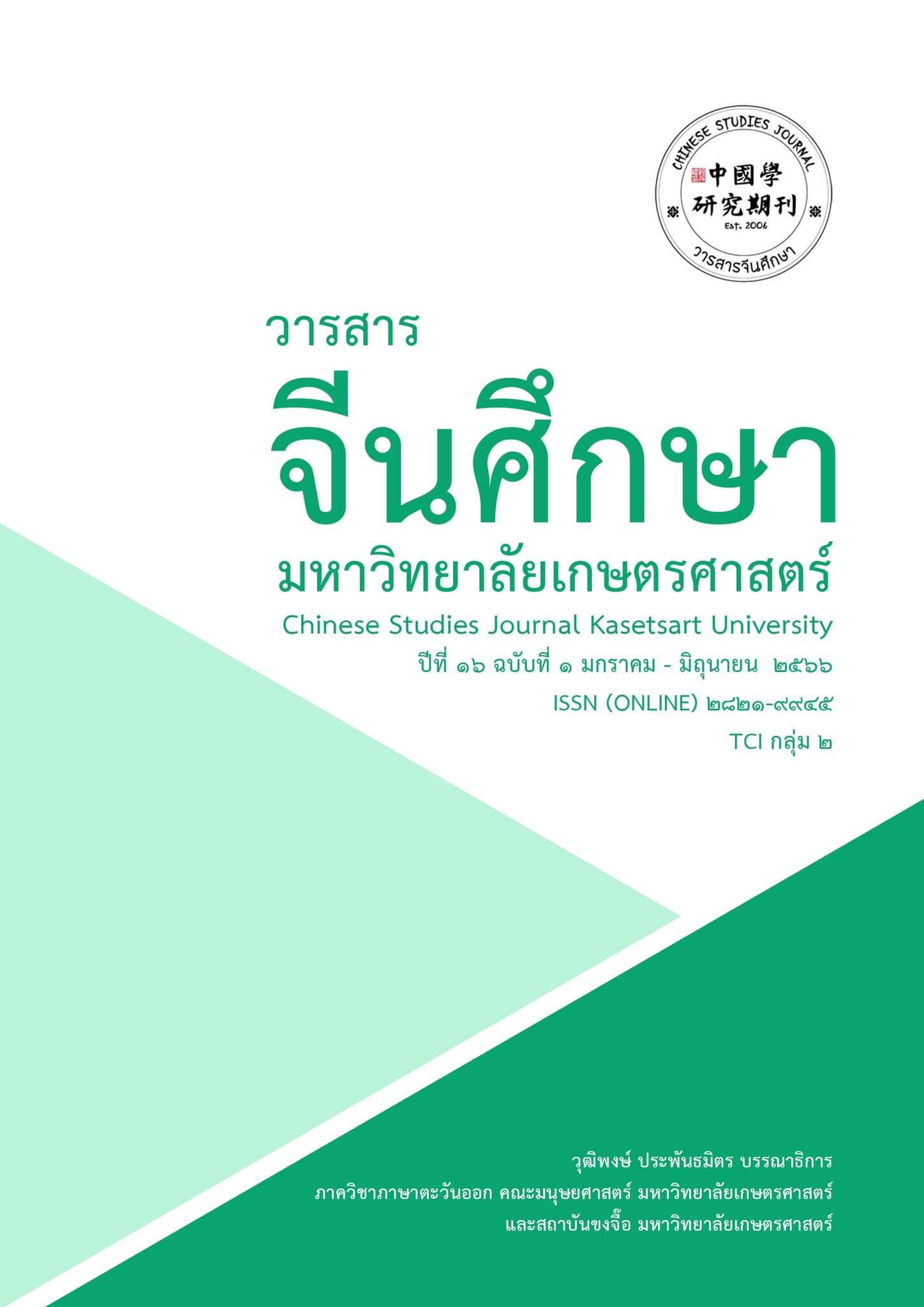การวิเคราะห์เปรียบต่างคุณสมบัติทางความหมายของหน่วยสร้างกริยา-ส่วนเสริมกริยาบอกผล และส่วนเสริมกริยาบอกทิศทางในภาษาจีนกับหน่วยสร้างกริยาเรียง ที่สื่อความหมายเดียวกันในภาษาไทย A Comparative Analysis of the Semantic Features of Resultative and Directional Verb Complement Construction in Chinese and Similar Serial Verb Construction in Thai
Main Article Content
บทคัดย่อ
ภาษาไทยและภาษาจีนมีลักษณะทางภาษาที่คล้ายกันและสื่อความหมายลักษณะเดียวกันอยู่หลายแบบ ตัวอย่างหนึ่งที่เห็นได้ชัดคือการเรียงตัวกันของคำกริยาตั้งแต่สองตำแหน่งขึ้นมาโดยไม่มีคำเชื่อมมาแทรกระหว่างกลางและกริยาตัวที่สองสื่อความหมายบอกผลหรือบอกทิศทางให้แก่กริยาตัวแรก แต่ลักษณะดังกล่าวได้รับการจัดประเภทในระบบไวยากรณ์ที่แตกต่างกันในทั้งสองภาษา กล่าวคือ ภาษาจีนจะเรียกลักษณะนี้ว่า “หน่วยสร้างกริยา-ส่วนเสริมกริยาบอกผล (动结式)” และ “หน่วยสร้างกริยา-ส่วนเสริมกริยาบอกทิศทาง (动趋式)” แต่ไม่พบการกำหนดเป็นลักษณะทางไวยากรณ์ในระบบไวยากรณ์ไทย การรับรู้ลักษณะทางไวยากรณ์นี้จะปรากฏอยู่ในผลงานวิจัยทางภาษาศาสตร์ภาษาไทยและเรียกชื่อว่า “หน่วยสร้างกริยาเรียง” (Serial Verb Construction, SVC) ซึ่งมีประเภทย่อยเป็น “หน่วยสร้างกริยาเรียงสื่อผลลัพธ์ (Resultative SVC)” และ “หน่วยสร้างกริยาเรียงสื่อทิศทาง (Directional SVC)” การจัดประเภทที่แตกต่างกันในสองภาษานี้สะท้อน “สถานะ” ของกริยาตัวที่สองในหน่วยสร้างที่แตกต่างกันเช่นกัน กล่าวคือหน่วยสร้างของภาษาจีนจะกำหนดให้กริยาตัวที่สองมีสถานะเป็น “ส่วนเสริมกริยา” ซึ่งมีสถานะรองจากกริยาตัวที่หนึ่งซึ่งเป็นกริยาหลัก แต่หน่วยสร้างของภาษาไทยกำหนดให้กริยาทุกตัวในหน่วยสร้างมีสถานะเป็นกริยาแท้เท่ากันและเรียงต่อกันเพื่อแสดงความหมายที่เชื่อมต่อกัน งานวิจัยนี้จึงมุ่งศึกษาความเหมือนต่างทางความหมายของหน่วยสร้างที่มีความคล้ายคลึงกันในสองภาษานี้
ผลการวิจัยพบว่า หน่วยสร้างกริยา-ส่วนเสริมกริยาบอกผลสื่อความหมายได้ 3 รูปแบบ ได้แก่ ความหมายสื่อนามสภาวะ ความหมายสื่อกริยาสภาวะและความหมายสื่อกาลสภาวะ โดยรูปแบบความหมายสื่อนามสภาวะ มีการถ่ายทอดความหมายที่มีลักษณะเดียวกันกับหน่วยสร้างกริยาเรียงสื่อผลลัพธ์ต้นแบบในภาษาไทย ในขณะที่รูปแบบสื่อกริยาสภาวะและกาลสภาวะ เมื่อเทียบความหมายกับภาษาไทยแล้ว จะอยู่ในระดับหน่วยสร้างกริยาเรียงชายขอบ สำหรับหน่วยสร้างกริยา-ส่วนเสริมกริยาบอกผลสามารถสื่อความหมายได้ 3 รูปแบบ ได้แก่ ความหมายสื่อทิศทาง ความหมายสื่อผลลัพธ์และความหมายสื่อกาลสภาวะ โดยรูปแบบความหมายสื่อทิศทาง เป็นรูปแบบความหมายเดียวกันกับหน่วยสร้างกริยาเรียงสื่อทิศทางต้นแบบในภาษาไทย รูปแบบความหมายสื่อผลลัพธ์เทียบเคียงได้กับหน่วยสร้างกริยาเรียงสื่อทิศทางชายขอบ และรูปแบบความหมายสื่อกาลสภาวะเป็นรูปแบบความหมายที่ไม่สามารถเทียบเคียงได้กับหน่วยสร้างกริยาเรียงบอกทิศทางในภาษาไทยได้
Article Details

อนุญาตภายใต้เงื่อนไข Creative Commons Attribution-NonCommercial-NoDerivatives 4.0 International License.
ผลงานทางวิชาการที่ลงตีพิมพ์ในวารสารจีนศึกษา มหาวิทยาลัยเกษตรศาสตร์ เป็นลิขสิทธิ์ของผู้เขียนหรือผู้แปลผลงานนั้น หากนำลงในวารสารจีนศึกษาเป็นครั้งแรก เจ้าของผลงานสามารถนำไปตีพิมพ์ซ้ำในวารสารหรือหนังสืออื่นได้โดยมิต้องแจ้งให้ทราบล่วงหน้า แต่หากผลงานที่ได้รับพิจารณานำลงในวารสารจีนศึกษา เป็นผลงานที่เคยตีพิมพ์ที่อื่นมาก่อนเจ้าของผลงานต้องจัดการเรื่องปัญหาลิขสิทธิ์กับแหล่งพิมพ์แรกเอง หากเกิดปัญหาทางกฎหมาย ถือว่าไม่อยู่ในความรับผิดชอบของวารสารจีนศึกษา มหาวิทยาลัยเกษตรศาสตร์ ทั้งนี้ ความคิดเห็นต่างๆ ในบทความเป็นความคิดเห็นส่วนตัวของผู้เขียน ไม่เกี่ยวกับกองบรรณาธิการวารสารจีนศึกษา มหาวิทยาลัยเกษตรศาสตร์
เอกสารอ้างอิง
Alexandray Aikhenvald, &R. M. W. Dixon. (2006). Serial Verb Constructions A Cross-Linguistic Typology. Oxford University Press.
Cholthicha Sudmuk. (2005). The Syntax and Semantics of Serial verb Constructions in Thai [doctoral dissertation]. University of Texas.
Kiyoko Takahashi. (2009). Basic Serial verb Constructions in Thai. Journal of the Southeast Asian Linguistics Society, 215-229.
Paul R. Kroeger. (2004). Analyzing Syntax A Lexical-Functional Approach. Cambridge University Press.
William J. Frawley. (2003). International Encyclopedia of Linguistics. Oxford University Press.
กิ่งกาญจน์ เทพกาญจนา. (2553). หน่วยสร้างกริยาเรียงต้นแบบในภาษาไทย. ในอมรา ประสิทธิ์รัฐสินธุ์ (บรรณาธิการ), หน่วยสร้างที่มีข้อขัดแย้งในไวยากรณ์ไทย (พิมพ์ครั้งที่ 2, น. 66-173). โรงพิมพ์แห่งจุฬาลงกรณ์มหาวิทยาลัย.
ธีรวัฒน์ ธีรพจนี. (2563). การศึกษาวิเคราะห์คุณลักษณะของหน่วยสร้างกริยา-ผลเพื่อการสอนภาษาจีนในฐานะภาษาต่างประเทศ. วารสารภาษาและภาษาศาสตร์, 38(1), 54-71.
ยาใจ ชูวิชา. (2536). ความเป็นประโยคของหน่วยสร้างกริยาเรียงในภาษาไทย [ปริญญานิพนธ์ระดับดุษฎีบัณฑิต]. จุฬาลงกรณ์มหาวิทยาลัย.
ราชบัณฑิตยสถาน. (2556). พจนานุกรมฉบับราชบัณฑิตยสถาน พ.ศ.2554. ศิริวัฒนาอินเตอร์พริ้นท์.
ราชบัณฑิตยสถาน. (2560). พจนานุกรมศัพท์ภาษาศาสตร์ (ภาษาศาสตร์ทั่วไป). เอบิซ อินเตอร์กรุ๊ป
วิจินตน์ ภาณุพงศ์. (2532). โครงสร้างของภาษาไทย: ระบบไวยากรณ์ (พิมพ์ครั้งที่ 10). สำนักพิมพ์มหาวิทยาลัยรามคำแหง.
อัญชลี สิงห์น้อย วงศ์วัฒนา. (2555). ชุดกริยาในภาษาไทย: กริยาเรียงหรืออื่นใด?. วารสารภาษาและวัฒนธรรม, 31(2), 35-66.
Beijing Daxue Zhongwen Xi Xiandai Hanyu Jiaoyanshi 北京大学中文系现代汉语教研室. (1993). Xiandai Hanyu《现代汉语》. Shangwu Yinshuguan 商务印书馆.
Ding, S.丁声树. (1961). Xiandai Hanyu yufa jianghua《现代汉语语法讲话》. Shangwu Yinshuguan商务印书馆.
Huang, B, & Liao, X. 黄伯荣, & 廖序东. (1991). Xiandai Hanyu《现代汉语》. Higher Education Press高等教育出版社.
Liu, Y., Pan, W., & Gu, W. 刘月华, 潘文娱& 故韡. (2001). Shiyong Xiandai Hanyu Yufa《实用现代汉语语法》. ShangwuYinshuguan商务印书馆.
Zhu, D. 朱德熙. (1982). Yufa Jiangyi《语法讲义》. Shangwu Yinshuguan商务印书馆.


